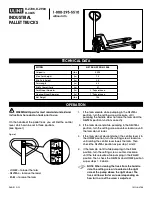
5-27
TRAVELING WITH LOAD
TRAVELING WITH LOAD
Travel with load or carriage as low as possible and tilted back. Never travel with the load or carriage
raised (elevated) in a high position. Do not elevate the load except during stacking.
Observe all traffic regulations and watch for other traffic, pedestrians, and safe clearances. Always
look in the direction of travel. Keep a clear view of the path of travel and when the load blocks your
visibility, travel in reverse with load trailing (Except when climbing an incline).
Avoid sudden movements when carrying a load-start, stop, travel, steer, and brake smoothly. Steer
clear of bumps, holes, and loose materials or debris on the ground. Lift and tilt slowly and smoothly.
Go slowly when turning. Cross railroad tracks slowly and at an angle wherever possible.
Use special care when handling and traveling with long, high, or wide loads-to avoid losing the
load, striking bystanders or obstructions, or tipping the truck.
Watch clearances around the truck and load as you travel. Raise the forks or attachment only to
pick up or stack a load. Look out for obstructions, especially overhead.
Be aware that exaggerated tail swing, when turning while traveling forward, is a characteristic of lift
trucks that are steered by the rear wheels. Accordingly, you need to become accustomed to tail
swing and always check the tail swing area of the counterweight to be sure it is clear before you
turn.
Always be concerned about the stability of your lift truck. When attachments are used, extra care
should be taken in securing, manipulating, positioning, and transporting the load. Because
attachments generally add extra weight and complexity to the truck, operate trucks equipped with
attachments as partially-loaded trucks when not handling load.
4)
4)





































